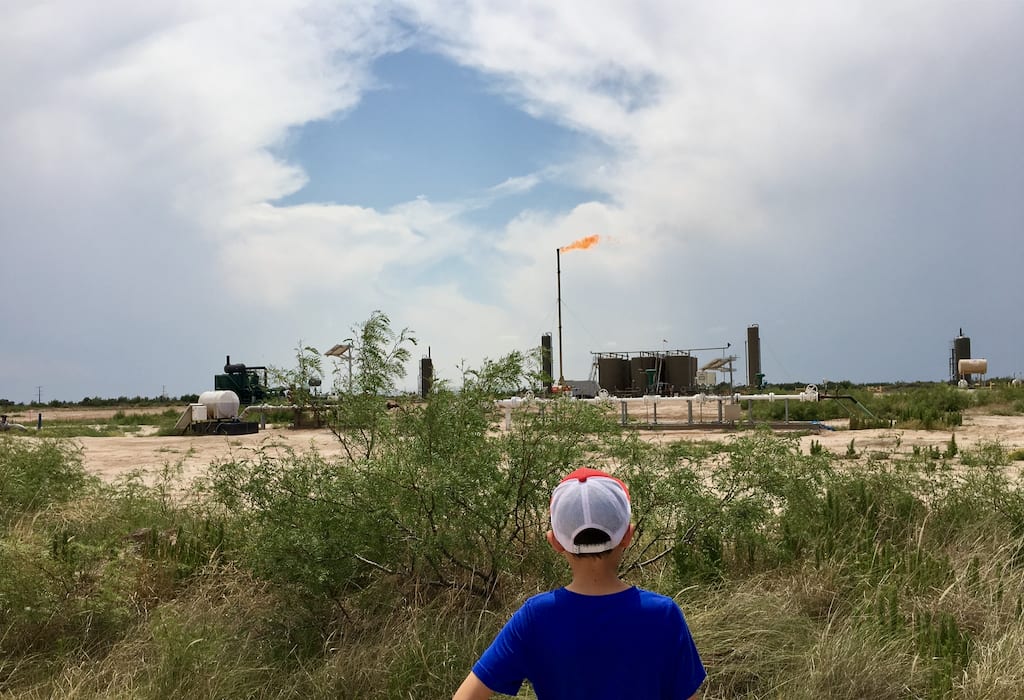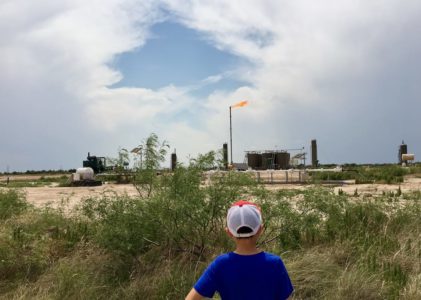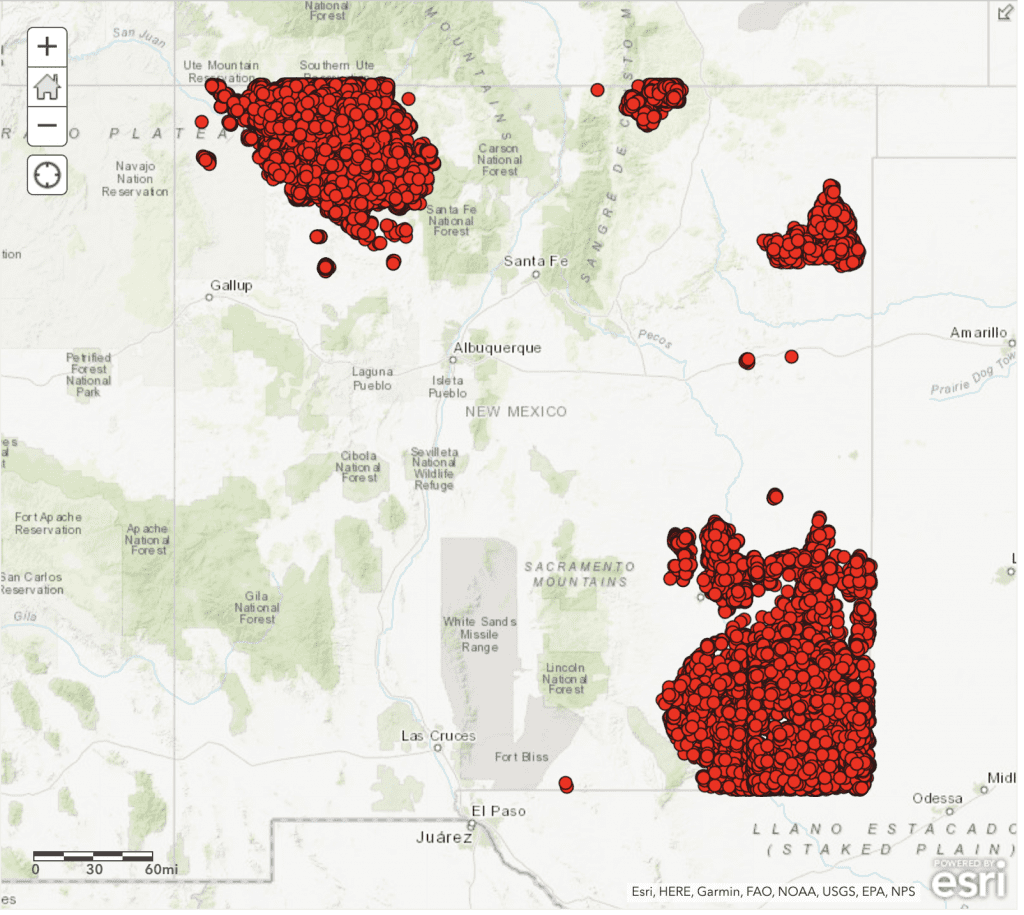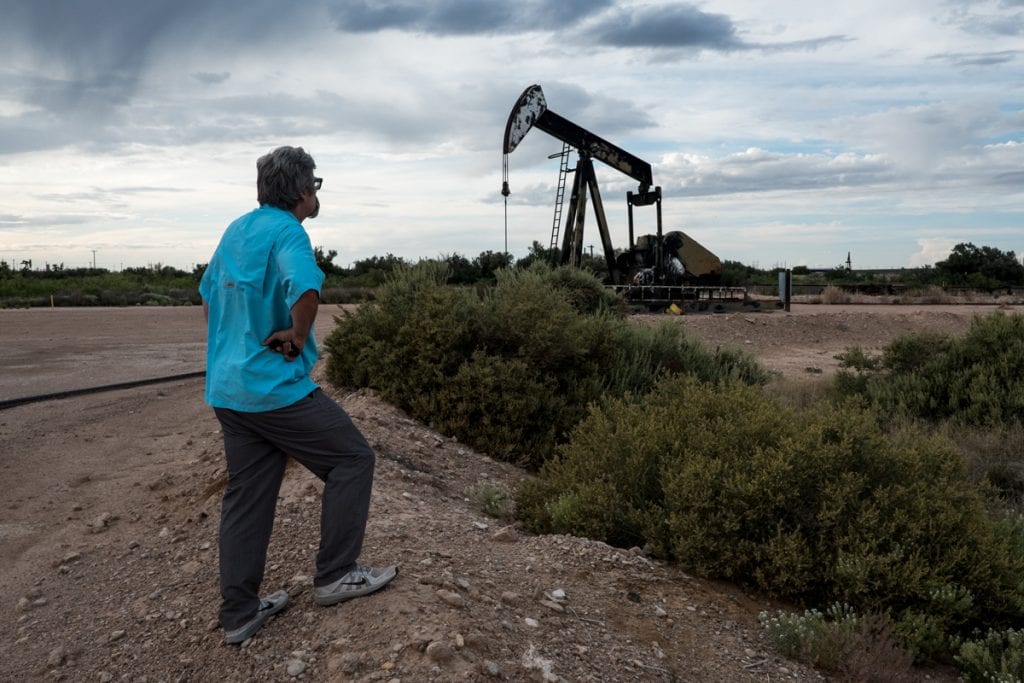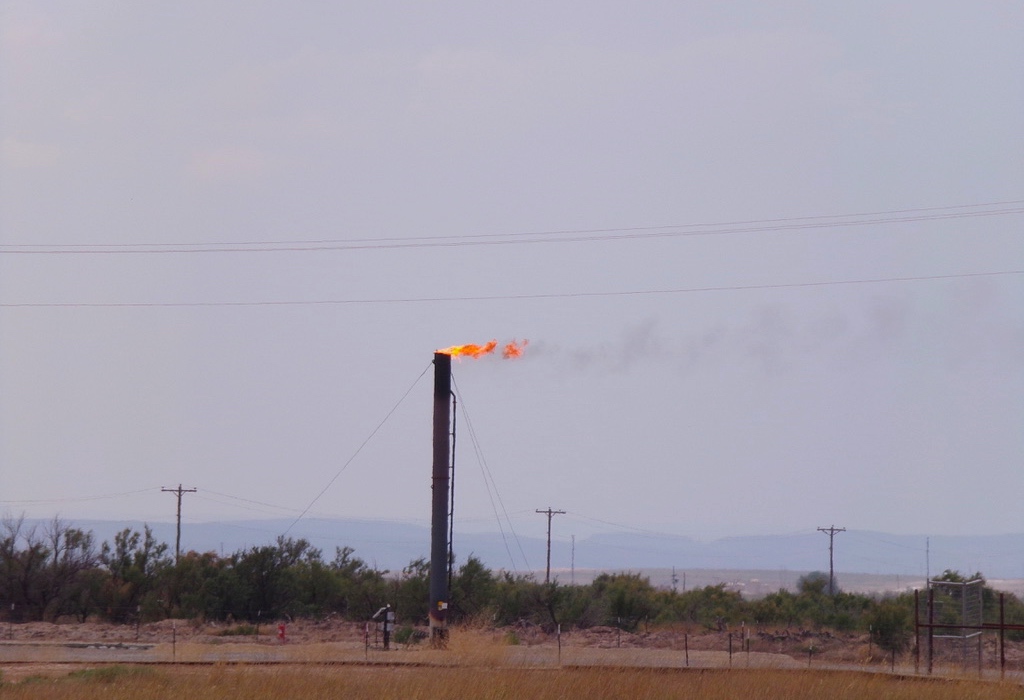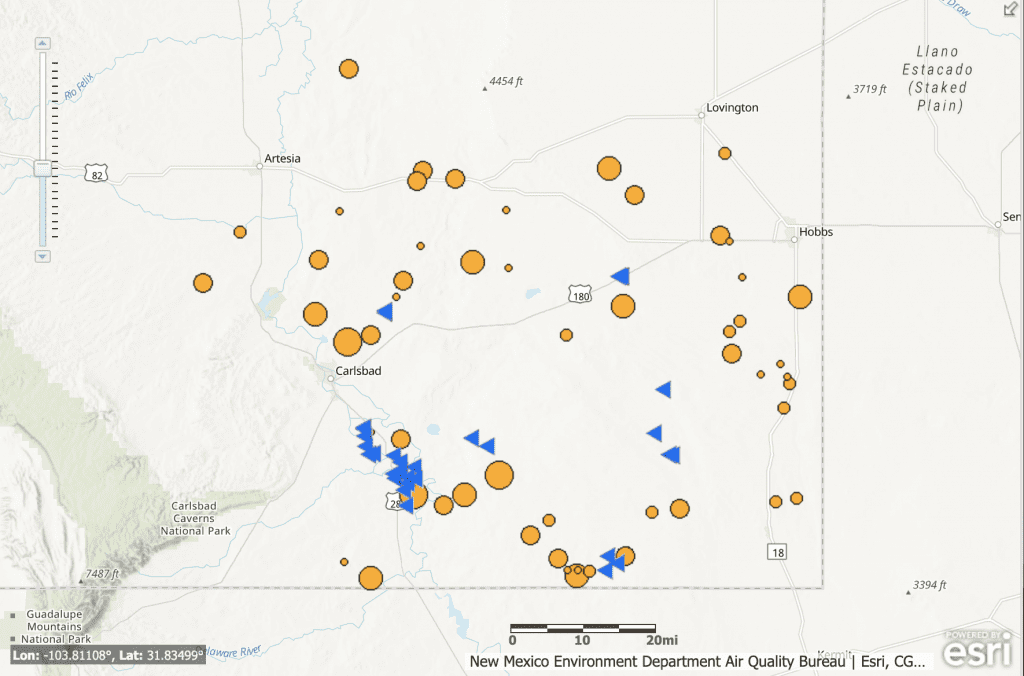While air pollution from oil and gas extraction in New Mexico is on the rise, state regulators are effectively turning their backs on serious clean air problems and real solutions to meaningfully rein in the fracking industry’s toxic emissions.
It’s why WildEarth Guardians is working to confront New Mexico regulators and ensure they’re held accountable to putting climate, clean air, and health first.
A Growing Air Quality Disaster
It’s no secret that in New Mexico, the oil and gas industry is one the state’s largest sources of air pollution. Just in the last decade, companies have drilled unprecedented amounts of new wells, increasing oil and gas production more than 125%.
This development has unleashed a surge in emissions that have eroded clean air, filled the skies with more greenhouse gases, and undermined public health.
According to the American Lung Association, New Mexico now has failing air quality throughout the state. Reports further indicate that releases of methane, a potent greenhouse gas, from the oil and gas industry are higher than ever.
These impacts have been especially felt by people living in the heavily fracked northwest and southeast corners of New Mexico.
While there are more than 57,000 active wells in the entire state, more than 21,500 are located in the northwest, often referred to as the Greater Chaco region, and more than 34,300 are in the southeast, often referred to as the Greater Carlsbad region.
Location of active oil and gas wells in New Mexico. Most wells are located in the northwest and southeast parts of the state (data from New Mexico Oil Conservation Division).
This pollution has especially endangered Navajo communities in the Greater Chaco region, as well as people living in and near the town of Carlsbad.
A Soaring Smog Problem
Perhaps the most vivid sign of how bad oil and gas has made the air in New Mexico is to look at ground-level ozone monitoring data from across the state.
The key ingredient of smog, ground-level ozone is a poisonous gas that forms when pollution from tailpipes, smokestacks, and oil and gas operations react with sunlight.
Ground-level ozone is so poisonous that even at very small concentrations, it can cause serious respiratory damage. Because of its risks, the U.S. Environmental Protection Agency has established health standards for ozone, limiting concentrations in the ambient air to no more than 70 parts per billion.
While normally ozone is a big city problem, it’s well known that oil and gas extraction can be a major contributor to ozone pollution, particularly in the western U.S.
The two key pollutants most responsible for forming ozone are volatile organic compounds and nitrogen oxides. The oil and gas industry is a huge source of these gases.
Drilling, fracking, pipelines, and other operations and equipment release huge amounts of volatile organic compounds, a natural component of oil and gas and a key byproduct of production. Engines used for drilling, natural gas compression, trucks, pumps, and more are also major sources of nitrogen oxides.
Oil and gas well site in northwest New Mexico, complete with engines, tanks, pipelines, and many other sources of air pollution.
Given this, it’s no surprise that the areas of New Mexico experiencing the highest ozone are the northwest and southeast portions of the state.
In fact, the ozone monitor in the town of Carlsbad in Eddy County has recorded the highest levels of ozone pollution in the state. Ozone has been so high in Carlsbad, it’s been comparable to pollution in big cities like Denver, Houston, and Los Angeles.
The numbers simply don’t lie: the oil and gas boom in New Mexico is fueling a dangerous smog boom.
The State’s Response? Keep Permitting More Fracking
In spite of high ozone, the New Mexico Environment Department continues to approve permits for the oil and gas industry to build new sources of air pollution.
Even in southeast New Mexico, where monitors are clearly violating ozone health standards adopted by the U.S. Environmental Protection Agency, the Department is rubber-stamping dozens of new permits monthly.
Just this week, WildEarth Guardians commented on dozens of new permit proposals, including for a natural gas compressor station in Eddy County and for more than 20 permits for other oil and gas production facilities.
At a hearing in June, the Environment Department stated that in southeast New Mexico, more than 30 permits are being approved every month.
Each new permit authorizes companies to release more volatile organic compounds and more nitrogen oxides, the very pollutants that are fueling the region’s ozone violations.
From a health standpoint, it’s insane that the Environment Department keeps approving more permits for more pollution, effectively worsening ozone problems in the state. However, it’s also illegal.
Under New Mexico law, the Environment Department must deny pollution permits if they would cause or contribute to violations of air quality standards. The agency’s regulations explicitly state that permits can’t be approved where emissions would “cause or contribute” to air pollution in excess of ambient air quality standards.
Section 20.2.72.208 of the New Mexico Administrative Code, which states plainly that the Environment Department can’t approve permits for sources of pollution that would worsen air quality problems.
That’s why over the past few months, WildEarth Guardians has been filing legal appeals of the New Mexico Environment Department’s approval of new permits for the oil and gas industry to pollute.
In petitions filed in May and June, we called on the New Mexico Environmental Improvement Board, an appeals board comprised of citizens, to overturn the Environment Department’s permits. Just this week, we filed an expert report highlighting how the Department’s permitting defies facts and reality.
In the meantime, the New Mexico Environment Department keeps cranking out the permits. Just this week, the Department published notice that it intends to approve a pollution permit that would allow Exxon subsidiary, XTO Energy, build a massive new gas processing plant in southeast New Mexico.
New Regulations: Hope or Hot Air?
To their credit, the New Mexico Environment Department has proposed to adopt new rules that the agency claims will reduce oil and gas industry emissions and rein in the state’s ozone pollution.
As part of an “Ozone Attainment Initiative,” the Department released draft regulations at the end of July and is now asking for public comment on the rules.
While a refreshing step forward for clean air in New Mexico, a closer look at the proposed rules leaves much to be desired.
For one, the Environment Department hasn’t completed any modeling to demonstrate the draft rules will actually reduce ozone to safe and healthy levels. While modeling is in the process of being completed for the “Ozone Attainment Initiative,” a recent presentation indicates it won’t actually be done until after November 2020.
The draft rules are also riddled with loopholes and exemptions, including a proposal to exclude small oil and gas well sites (often called “stripper wells”) from regulation. It’s estimated this “small well exemption” would apply to around 95% of all wells in New Mexico, effectively keeping the industry unregulated.
Also of concern is that the rules continue to allow the oil and gas industry to flare as a means to control air pollution. Burning gases to control emissions is a wasteful and, in many cases, just as polluting practice.
Not surprisingly, in a virtual public meeting held this week, the New Mexico Environment Department faced extensive criticism over the loopholes and exemptions in its draft regulations.
More importantly, the draft rules completely ignore the need to address disproportionate impacts to people and communities living in close proximity to well sites, particularly Tribal communities, people of color, and low income or other marginalized groups.
Put another way, the rules do nothing to advance environmental justice and protect the most vulnerable, most discriminated, and most disenfranchised in New Mexico. It’s shocking given the Environment Department’s own stated commitment to advancing environmental justice in the state.
To be sure, the regulations are only draft at this point and we still have a lot of work to do to review, critique, and make recommendations to the Environment Department.
However, it is disappointing that the Environment Department has not put forward draft regulations that seem to fully rise to the challenge of protecting clean air, climate, and health in New Mexico.
Ultimately Industry Must be Held Accountable
Right now, the New Mexico Environment Department is certainly not doing everything it can and should to safeguard air quality and health in New Mexico. Amid recent revelations a critical ozone monitor in Carlsbad fell into disrepair, it’s clear the Department has to step it up.
However, it’s also clear that the oil and gas industry’s refusal to keep its toxic air pollution in check is making it more difficult than ever for regulators to effectively protect people.
As the industry rebounds after plummeting oil and gas prices earlier this year, reports indicate flaring and venting of natural gas has surged in New Mexico.
Company’s also continue to flout clean air laws and violate their pollution permits. Just last month, the Environment Department fined a company more than $5 million for ongoing illegal releases of toxic gases. Earlier this year, the agency put several companies on notice of outstanding clean air violations.
And in the last five years, oil and gas companies have repeatedly reported illegal emissions and been busted for violating their permits. The map below, which is from a New Mexico Environment Department online interactive map, shows just a few facilities in southeast New Mexico that have reported excess emissions or that have cited for violations.
Excess emission reporters are the orange circles. Oil and gas facilities busted for violating are the blue triangles.
The New Mexico Environment Department clearly needs to up its game and actions, but with the oil and gas industry’s defiance to clean air mounting, the challenge for the Department is increasingly immense.
Still, the reprehensible actions of fracking companies are no excuse for the Department to not do everything possible–and legally required–to put clean air, climate, and health first in New Mexico. This means taking action to deny pollution permits and to ensure that new rules truly deliver the strongest safeguards possible.
And ultimately it means taking action to help New Mexico put an end to fracking and start keeping oil and gas in the ground. As we’ve highlighted, the state can’t possibly protect clean air and the climate so long as oil and gas extraction occurs with impunity.
Stay tuned for updates, including information on how you can weigh in and help make a difference for climate, clean air, and health in New Mexico and beyond!
about the author:
Jeremy Nichols | Climate and Energy Program Director, WildEarth Guardians | Read more from Jeremy Nichols
